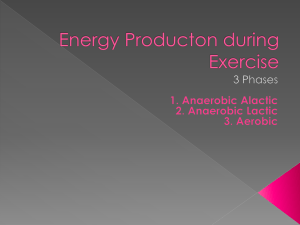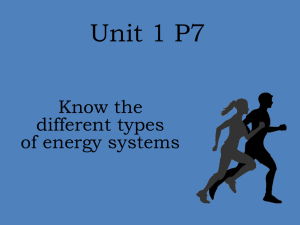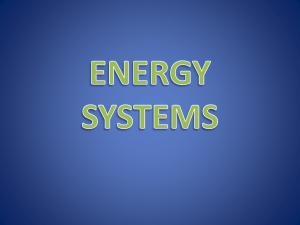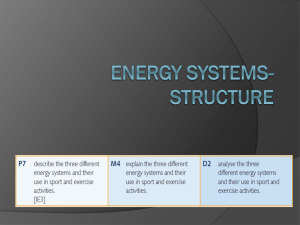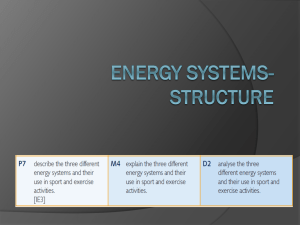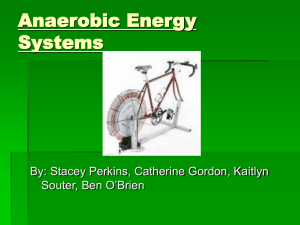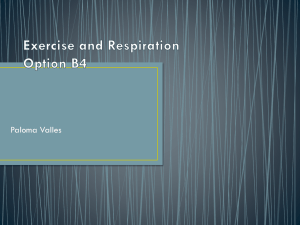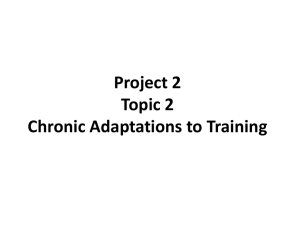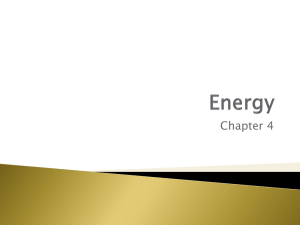Energy Systems - Horton High School
advertisement
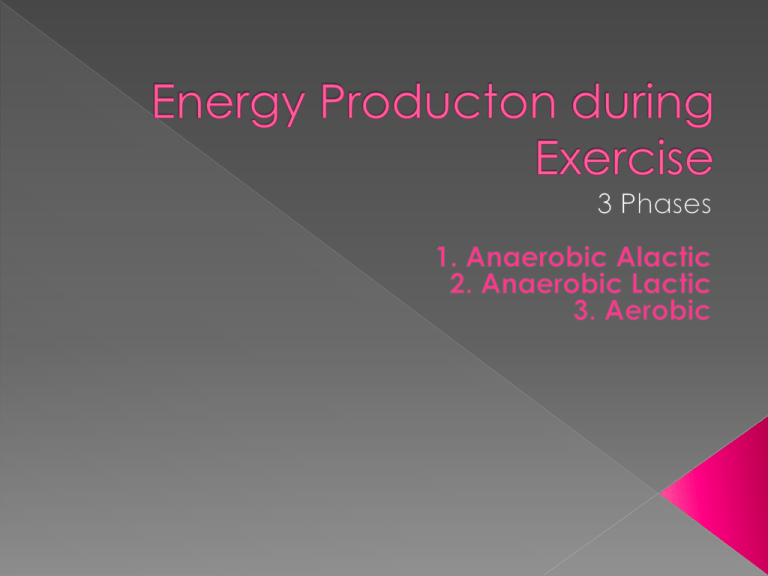
Metabolism – process of turning carbs, fats and proteins into energy to be used by our body. Glucose – the body processes food and turns it into glucose sugar molecules. It is then transformed into glycogen, the usual form in which the body stores carbohydrates in our muscles and liver for energy use. ATP – AdenosineTriPhosphate, the common energy molecule for all living things. ATP is like the gas our muscles use for energy. Glucose/Glucogen is converted to ATP before our muscles can use it for energy. Lactic Acid – a waste product produced during energy conversion during the Anaerobic/Lactic phase. It causes muscle fatigue. Alactic – energy produced with no lactic acid waste Anaerobic – energy produced without the need for oxygen. Aerobic – energy produced with oxygen ATP is the molecule that muscles use to release energy for movement All 3 energy phases work to produce ATP for energy during exercise but do it in different ways and produce different amounts of ATP A = Adenosine atom D = Di or means 2 atoms T = Tri or means 3 atoms P = Phosphate atom C = Creatine atom Example - ATP refers to a molecule made up of: 1atom adenosine, 3 atoms phosphate This process is called Anaerobic (without oxygen) and Alactic (no lactic acid produced) because it does not require O2 nor does it produce the lactic acid waste during energy production. Adenosinediphosphate (ADP) molecule combines with Phosphocreatine(PC) molecule to produce 1ATP molecule and 1Creatine molecule. Both ADP and PC can be found stored in the muscles This ATP can be used for quick energy but for only a few seconds because only small amounts of PC are stored in the muscles and are used up quickly. •It takes about 4 to 5 minutes of rest for the body to replace the PC stores to the muscles. •Important in short sprints or power weight lifting, high jump, etc. PC = Phospho Creatine ADP = Adenosinediphosphate PC and ADP molecules stored in our muscles in small amounts PC + ADP => ATP + C One ATP molecule produced plus a creatine atom Glucose stored in muscles is combined with ADP and Phosphate to create ATP energy molecules and Lactic Acid as a waste product. Creates twice the amount of ATP energy as Phase 1. Able to produce ATP energy without oxygen but due to lactic acid build up muscles fatigue after 2 to 3 minutes. Oxygen will work to break down the lactic acid waste during the next energy phase which is aerobic and allows the muscles to continue to perform. Important energy for many sports such as hockey, soccer, basketball that require short but repetitive bursts of energy. Glucose molecules are stored in muscles is shown as C6H12O6 6 Carbon atoms + 12 Hydrogen atoms +6 Oxygen atoms Glucose combines with 2 molecules of Adenosine Phosphate and 2 free phosphate atoms to produce ATP and 2 Lactic Acid molecules (waste) Lactic Acid molecule is shown as C3H6O3 3 Carbon atoms + 6 Hydrogen atoms + 3 Oxygen atoms C6H12O6 + 2ADP + 2P => 2C3H6O3 + 2ATP 2 ATP molecules formed (twice as much as Phase 1) but with Lactic acid waste After 2 – 3 minutes of exercise the build up of lactic acid impedes muscle performance and a third aerobic form of energy production takes over called aerobic. Oxygen is combined with Glucose, ADP and Phosphate to produce 18 times more ATP energy than phase 2. Carbon Dioxide and water waste is a by product. This energy system can produce energy for long durations and is limited only by the body’s store of glucose and its ability to provide oxygen to the muscles. Moderate exercise (jogging, repetitive sporting activity, etc) can be sustained for up to about 1 – 2 hours. Until the energy stores in the body are used up. Good cardio vascular fitness increases VO2 uptake and improves ones ability to sustain energy production during the aerobic phase. Oxygen combines with Glucose to produce ATP without Lactic acid Carbon Dioxide molecule is shown as CO2. Given off as waste in this process. C6H12O6+6O2+36ADP+36P => 6CO2+36ATP+6H2O 36 ATP produced with water and carbon dioxide waste. Much more energy than phase 1 or 2 Anaerobic Threshold refers to a point during aerobic exercise when your CV system cannot keep up to the demand for oxygen to produce energy. Max VO2 (the amount of oxygen you can deliver to the muscles in one minute) People with high levels of CV fitness have greater Max VO2 and a higher Anaerobic Threshold. It would take more effort before they reached this point. Exceeding the threshold requires the body to begin producing energy from phase 2 with lactic acid build up. See the next slide for an example In the first 10 seconds energy is anaerobic and alactic In the next 2 – 3 minutes energy is anaerobic and lactic From the 3 min to about the 1:30 min mark energy is aerobic (no lactic acid build up) The last 15 min the runner exceeds the anaerobic threshold and the extra energy is produced by the anaerobic and lactic system. This leads to exhaustion from lactic acid build up around the muscles Phase 1 is limited to about 10 – 15 seconds as it quickly uses up its store of PC molecules Phase 2 is limited to about 3 minutes as lactic acid waste acts to inhibit muscle contraction. It takes the oxygen in phase 3 to break down lactic acid and restore muscle ability. Phase 1 and 2 produce instant energy for explosive/quick movement. Phase 3 is good for long duration exercise at moderate rates. It uses oxygen to produce ATP molecules from glucose and ADP. While it produces much more energy than phase 1 or 2 it is limited by the amount of oxygen getting to the muscles, if exercise exceeds the VO2 intake, energy must be created by phase 2 leading to lactic acid build up and muscle fatigue. Phase 1 produces 1 ATP molecule Phase 2 produces 2 ATP molecules Phase 3 produces 36 ATP molecules Phase 3 aerobic energy produces vastly more energy than the first 2 energy systems. So long as there is enough oxygen and glucose stores one can continue to exercise 1. 2. How is Lactic Acid a factor in the NHL when the puck is iced? If you don’t know the icing rule ask around and find out. Why do coaches sometimes use their time outs during this play? Use the example of a cross country runner who gets in a foot race with another runner the last K of a 7 K race to answer the question below. Explain why the runner with the higher Anaerobic Threshold has the better chance of winning. Answers should be about one paragraph and well written.

